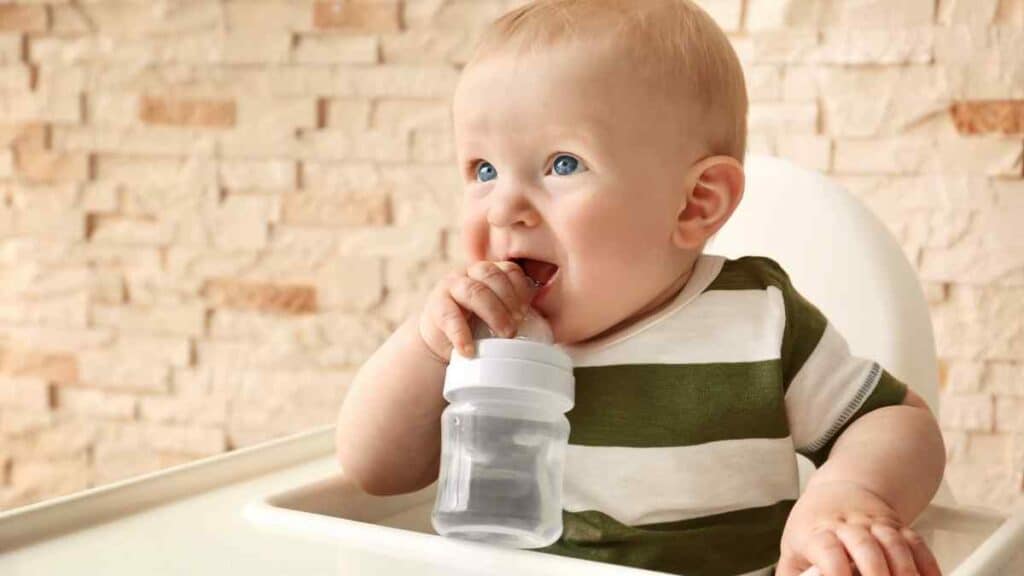Transitioning your baby from a bottle to a cup is a significant step in their developmental journey. It’s an exciting milestone that comes with its own set of challenges, unique considerations and need for readiness. This guide provides an overview of the signs to look out for in baby’s readiness, developmental milestones and behavioral cues to start the transition, choices of cups for transitioning, tips for a smooth transition, managing hydration and nutrition during this change, navigating the night-time transition, and special considerations for breastfed babies, special needs children, and multiple babies. This journey requires patience, persistence and individualized attention to your baby’s unique needs. As you walk along this path, remember to celebrate each small victory and relish these proud parenting moments. The transition from a bottle to a cup is not just about sipping or straws. It’s a significant stride in your baby’s growth and development.

Babies’ Signs of Readiness
Before embarking on any new venture, such as determining when should babies switch from bottles to cups with straws, it is key to identify if your baby is ready. This readiness can be evaluated across three primary parameters: developmental milestones, the baby’s physical and cognitive abilities, and behavioral cues. By understanding these signs of readiness, you can ensure that your baby transitions to using various types of drinking cups, such as an open cup or one with a straw, at the right time for them, supporting smooth and healthy developmental progress.
Developmental Milestones
Developmental milestones are specific capabilities that most children can do by a certain age. They play an important role in understanding when babies should switch from bottles to cups with straws. Measuring these milestones accurately can provide insights into your baby’s physical and cognitive development, such as their ability to handle an open cup or a cup with a straw. These milestones might entail language skills, motor skills, and social interaction capacities.
Baby’s Physical and Cognitive Abilities
Babies’ physical and cognitive abilities are essentially the skills that enable them to interact with their surroundings, including the use of various drinking cups. Each baby progresses at his or her own pace. Pay attention to the development of their motor skills, such as grasping, which is vital for managing cups, rolling over, sitting, crawling, and walking. Look out too, for cognitive abilities, like smiling, recognizing familiar faces, manipulating drinking tools (like a cup or a straw), and making simple associations.
Behavioral Cues
Behavioral cues can also indicate when your baby is ready to transition from a bottle to a cup. These cues are simply ways in which babies express their needs or wants. They are vital in understanding the baby’s ability to control the flow of liquid in their mouth from straw drinking or an open cup.
- Attentiveness: Your baby might be ready for a drinking transition if they show increased interest in their surroundings, including your drinking habits.
- Nervous behaviors: Increased fussiness or restlessness during feeding could indicate they are ready for a change—in this case, switching from a bottle to various kinds of drinking cups.
- Improved coordination: If your baby begins showing improved motor skills, such as holding up their head or reaching for objects—especially your drinking cup—these can be signs they’re ready for a transition.
Remember, each baby is unique, and their readiness might not align perfectly with these general guidelines. Always consult with your pediatrician or a healthcare provider when unsure. Whether it’s determining when your baby can manage a cup or how well they can control the cup to mouth flow, each developmental milestone is significant and special in its way.

Choosing the Right Time
Deciding when to introduce new challenges or experiences to your baby—such as transitioning from bottle feeding to using drinking cups or determining the best sippy cup—is crucial. It’s a complex matter that requires careful consideration of age-appropriate timing, an individualized approach, and avoiding rushed transitions. Moreover, the transition should complement the introduction of solid foods as it could influence how your baby uses their mouth in consuming different textures. Making mindful introductions can make each developmental phase much more fruitful and enjoyable for your child.
Age-Appropriate Timing
Each milestone related to baby’s mouth development, like transitioning from a bottle to a cup, has an age range in which most children will achieve it. These age ranges provide a guide about when you can expect your child to successfully navigate new challenges, such as handling drinking cups or starting on solid foods. However, remember that these are rough estimates, and variations are completely normal depending on the child’s individual development.
Individualized Approach
Different babies develop differently even when they are of the same age. Hence, it is vital to structure the timing of new skills and experiences according to their unique development pace and their specific skill sets. Observing your child closely to understand their strengths, weaknesses, and inclinations can guide you to choose the optimal time.
Avoiding Rushed Transitions
Rushing your child into a new phase before they’re ready can create unnecessary stress for both of you. It’s crucial to ensure your child has fully mastered their current developmental stage before moving on to the next one. It’s important that they feel secure and confident with their skills to make smoother transitions.
As always, consider consulting a pediatrician or a healthcare provider to guide you in navigating these crucial developmental stages.
Cup Options for Transitioning
Making the transition from a bottle or bottle feedings to a cup is a significant step in a baby’s life. Two popular choices for this transition are sippy cups and straw cups, sometimes also referred to as open cups or big kid cup. Each has its advantages and unique features, so it’s worth exploring both options to determine what will be the best fit for your child.
Sippy Cups
Sippy cups are specially designed for babies and toddlers and often used as an intermediary between the morning bottle and eventually a regular cup, to prevent spills when they are learning to sip.
Features and Advantages of Sippy Cups
- Sippy cups typically have handles and a tight-fitting lid with a spout.
- Easy transition: The spout mimics a bottle nipple, which can make the transition to sippy cup altogether a smoother experience.
- Spill-proof: Sippy Cups often come with valves that can be inserted to prevent spills.
- Independence: The easy-to-grip handles can help build independence in drinking.
Types and Varieties
Sippy Cups come in various types, including those with detachable handles, soft spouts, silicone spouts, and plastic spouts. You might try different varieties to find what suits your baby best.
Straw Cups
Straw cups offer another great option for transitioning your baby from a bottle to a cup.
1. Benefits of Straw Cups
Straw cups come with a number of benefits:
–Promote proper tongue and jaw development: Sipping from a straw helps in the development of oral muscles.
–Encourage better swallowing: Straw sips naturally position the tongue for a proper swallow.
–Versatility: Straw cups can be used with a variety of beverages.
2. Different Straw Cup Designs
Straw cup designs can vary. Some come with a weighted straw to allow your baby to drink at any angle, while others may be insulated to keep beverages cool. Some models may offer flip tops for added cleanliness, while others can be connected to a lanyard to avoid misplacement.
Remember, the best cup for your baby ultimately depends on their individual needs and preferences. Patience and experimentation may be needed to find what works best.

Getting Started: The Transition Process
Transitioning from a bottle or breastfeeding to a cup is a big leap in your child’s growth journey. This phase should be approached with careful planning and patience. A slow and steady approach with familiarization to the new cup, coupled with persistence, can make this transition smooth and enjoyable.
Gradual Introduction
Start the journey by gradually introducing the new cup. You could begin by filling the new cup with a small amount of water or juice during mealtimes. The idea is to have your baby become accustomed to sipping from a cup without being overwhelmed.
Familiarization with the New Cup
Allow your child to familiarize themselves with the new cup. Let them play with it and explore it while it’s empty. You can even drink from it yourself to show them how it’s used. The goal is to ensure that the cup is not seen as a strange or scary object but as a fun new thing to discover.
Patience and Persistence
Patience is the key. There might be spills, refusals, and some days where they rather stick to the bottle. Be consistent, but do not rush the process. Be there to encourage and applaud every small success. Remember, each child is unique and may take a different amount of time to achieve this milestone. Rewriting the script of bottle or breastfeeding doesn’t happen overnight, but with patience and persistence, your baby will soon master this new skill.
Tips and Tricks for a Smooth Transition
A gradual introduction of the new cup is essential, but additional strategies can help smooth the transition. Parents can use modeling behavior, offering positive reinforcement, being consistent in cup use, and tactfully dealing with resistance and challenges during the process. Deciding whether to use breast milk or another beverage during this transition can also be a key decision.
Modeling Behavior
Children naturally learn by observing others. Show your child how you drink from a cup and let older siblings or peers do it, too. By watching others drink from a cup, your baby can better understand the concept and may even try to imitate the behavior.
Offering Positive Reinforcement
Celebrate your child’s progress and success, no matter how small. Praising and encouraging them when they drink from the cup can boost their confidence and increase motivation. Focus on the positives and make drinking from the new cup a fun experience for your child.
Consistency in Cup Use
Ensure that you consistently offer the new cup to maintain your child’s familiarity with it. Keep the cup visible during mealtimes and other appropriate times. Encouraging regular use will help solidify the transition from the bottle or breastfeeding to using a cup. This consistent use should also include being mindful of brushing the child’s teeth or wiping their gums post feeding to prevent baby bottle tooth decay or tooth decay if using breast milk in the cups.
Dealing with Resistance and Challenges
Resistance and challenges during the transition are normal. Stay patient and observe any patterns in your child’s behavior. If your child seems too frustrated, consider easing the process by offering a familiar drink like breast milk or transitioning back to the bottle briefly before trying the new cup again.
Understanding your child’s unique pace and needs is vital to tackling setbacks. Don’t hesitate to consult with a pediatrician or healthcare provider if concerns arise during the transition process, particularly related to baby bottle tooth decay or other tooth decay issues.

Hydration and Nutrition During the Transition
As you introduce your child to a new way of drinking, it’s important to monitor their hydration and nutritional intake. This ensures that your child continues to receive all the necessary nutrients for healthy growth during and after the transition.
Maintaining Adequate Hydration
Ensuring your child stays properly hydrated is key. New cups can make drinking fun and exciting, but monitor your child’s fluid intake to make sure they’re getting enough. Look for signs of adequate hydration, such as regular wet diapers and a moist tongue and mouth.
Adaptation of Feeding Habits
It’s common for a child’s feeding habits to change slightly during this transition phase. They may initially drink less from the new cup than they did from a bottle. This is normal. Ensure they get sufficient nutrition through a balanced diet of solids or formula, depending on their age.
Balancing Milk and Water Intake
Balance is the key. During the transition, continue serving milk in the cup, as it remains a vital source of nutrition. You can introduce water, but it should not replace milk entirely. Make sure to follow the recommended daily milk intake for your child’s age. As always, follow your pediatrician’s advice for the best dietary balance for your child.
It’s beneficial to consult with your healthcare provider or a nutritionist to ensure the transition does not disrupt your child’s nutritional needs.
Navigating the Nighttime Transition
Transitioning from a bottle or breastfeeding to a cup also includes navigating nighttime feeds. This can be a bit more challenging, as night feeds often involve comforting routines that help the baby sleep. The following are some tips to make this transition smoother.
Transitioning During Night Feeds
Start this transition by incorporating the use of the new cup during the day. Once your child becomes accustomed to the cup, start introducing it during the night feeds as well. Keep in mind that consistency is essential here, but at the same time, transitioning during the night should be done delicately since it’s more associated with comfort and sleep.
One way to approach this is by implementing a calming bedtime routine. This could include reading a book, taking a bath, and then offering a drink from the new cup before sleep. The comforting actions paired with the use of the new cup should help your baby transition smoothly.
Strategies for Better Sleep
Toddlers often wake up at night due to habit more than hunger. Hence, one of the strategies to implement for better sleep involves gradually diluting the milk in their cup over a period of time so that it becomes less tempting to wake up. This practice might help break the cycle of waking up solely for the feed.
Additionally, teaching your child to self-soothe is important for continuous sleep. This might involve providing a comfort toy or blanket that your child associates with sleep.
Consulting with a healthcare provider or a sleep consultant can provide additional guidance tailored to your baby’s specific needs.

Special Considerations
The transition to using a cup can differ significantly based on a variety of factors, including whether babies are breastfed, if babies have special needs, or if families have twins or multiple babies.
Breastfed Babies and Transitioning
For breastfed babies, the transition might need a bit more patience since breastfeeding is not just about nutrition but also offers comfort and bonding time with the mother. One tip is to have another caregiver introduce the new cup, as babies may associate their mother more with breastfeeding. The key is to move at your baby’s pace and expect a few setbacks along the way.
Babies with Special Needs
Babies with special needs may require specialized cups or additional time for the transition. It’s crucial to work with a healthcare provider or an occupational therapist who can provide guidance based on your child’s unique needs. Remember, there’s no one-size-fits-all approach when dealing with babies with special needs—what matters most is finding what’s best for your child.
Twins and Multiple Babies
Dealing with twins or multiple babies, the transition can be more challenging as it requires coordinating the transition for more than one child. However, siblings often learn a lot from each other; hence, one twin’s successful transition might inspire and guide the others. Therefore, planning synchronized transition phases could work well for multiple babies.
Celebrating Milestones
As your child moves away from the bottle or breastfeeding and learns the skill to drink from a cup, these moments can be seen as significant milestones in their development, which should be celebrated.
Marking Successful Transitions
Take note of each successful transition—each time your baby successfully sips from the new cup, moves from a sippy cup to a straw, or eventually moves to use a standard cup. These are great opportunities to rejoice and affirm your child’s progress. You could use stickers, small rewards, or even a celebratory dance to mark the moments!
Proud Parenting Moments
These transitions can serve as a reminder of the valuable and hard work you are putting into your child’s upbringing. They’re milestones that can make you proud and give you joy. Share these moments with your partner, your family, or your friends. Remember to take a step back and appreciate the progression, the achievements, and the journey you are on as a parent.

Conclusion
The journey of transitioning a baby from a bottle to a cup is indeed a significant milestone filled with new experiences, tasks, and challenges. From recognizing the right signs of readiness, understanding developmental milestones and choosing between sip and straw, every decision matters. However, at the heart of it all is ensuring a smooth and healthy transition that suits your baby’s unique needs and pace. At every step, remember to celebrate these proud parenting moments and the incredible progress your baby makes. Because, beyond sipping or straws, it’s a journey of growth, discovery, and the joy of watching your little one takes confident strides in their developmental journey.
Did this article help you? Please let me know by commenting below. If you have any questions, don’t hesitate to ask!



